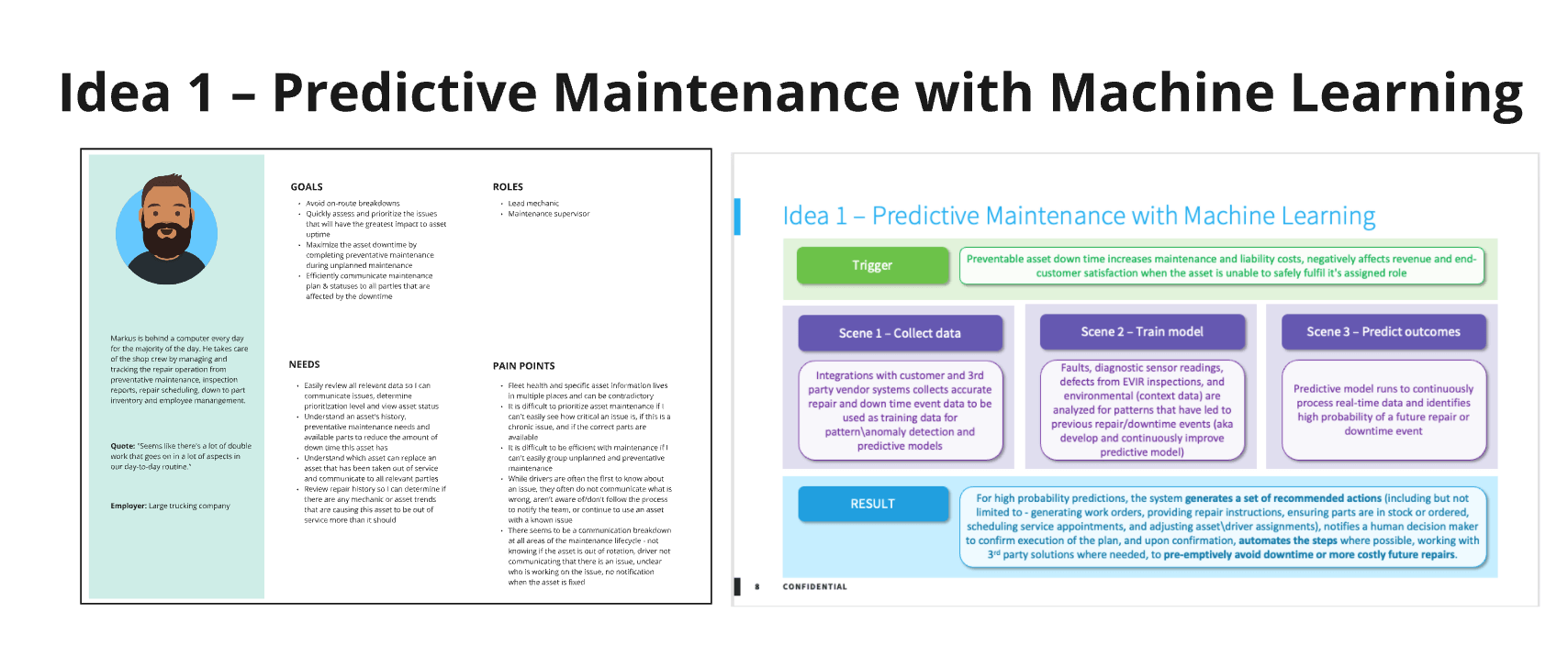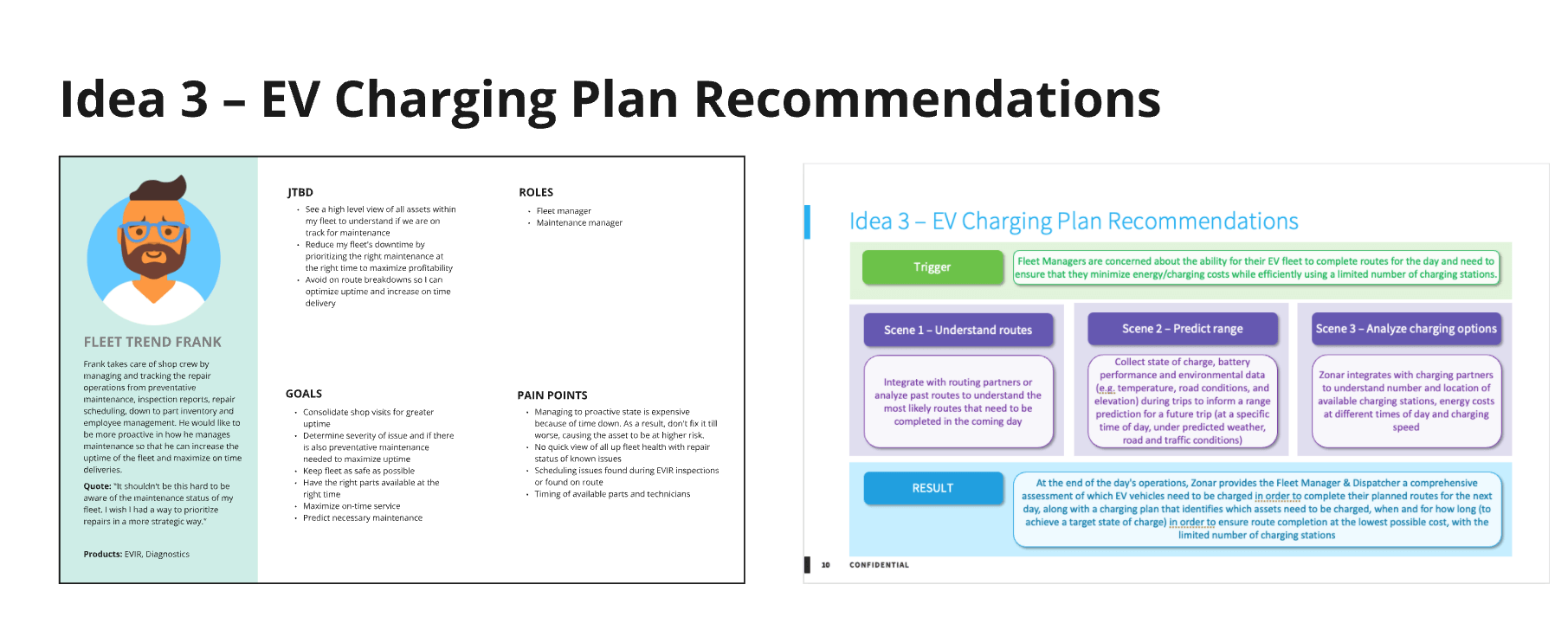Overview
The fleet management industry was rapidly evolving, with OEMs tightening control over vehicle data, AI reshaping operations, and fleets demanding smarter, higher-ROI solutions. As competition intensified and base services became commoditized, Zonar’s legacy SaaS offering and new platform solution faced new constraints.
To stay ahead, Zonar needed to offer flexible data solutions, predictive analytics, and task automation. To better understand what this would look like, Zonar explored an AI-first strategy to create an AI-assisted decision-making layer across data gathered from its telematics units, tablets, and smart cameras.
To explore AI's role in Zonar’s innovation, Amanda Parkhurst and I led a multi-stage workshop to generate AI solutions for customer value.
Business Value: Product Vision
Team: Myself & Amanda Parkhurst; participants
Role: Head of Design
“What would it look like if AI was a core part of our platform’s offering?”
An A.I. First Approach
AI First Product Thinking
To take a true AI first approach to rethinking our product experience, we needed to consider the overlap between the domain knowledge and associated data, the Job To Be Done, what AI capabilities provide to improve those jobs, and how we might approach the user experience to support the new capabilities with technology patterns that users might be less familiar with.
Questions we needed to ask:
What does our product look like if AI was the core offering instead of an add on?
What would the experience look like if it continuously learned and adapted to users needs?
What would it look like if the experience proactively predicted users needs?
How does the human fit in the “loop”?
What are the ethical considerations of this kind of approach?
To effectively structure our workshops, we utilized the Lawler Model for AI product development.
Understanding the Problem Space - What are the real world problems?
Data Consideration - Where will the data come from?
Algorithmic Choices - Decide on algorithmic architecture
Ethical Concerns - How will we deal with bias and safeguard those who use this?
Iterative Design - MVP and adjust as we go
Deployment and Monitoring - How will we roll this out?
This approach ensures that we avoid typical pitfalls of being giddy about AI
"Al washing" existing products without strategic purpose
Focusing on technical capabilities rather than user value
Work Session
Pain points and business value
Warm Up: We began the session by encouraging participants to explore various AI applications and consider how they could address challenges faced by Zonar’s customers.
“The focus of the framework is not to start with the technology and try to force-fit it into a solution. Rather, it starts with the problem and works its way forward”
We then shifted the focus away from the tech-first warm up to dive deeper on customer’s problems, irrespective of technology.
When AI is probably better (from Google)
Recommending different content to different users.
Prediction of future events.
Personalization improves the user experience.
Natural language understanding.
Recognition of an entire class of entities
Detection of low occurrence events that change over time.
An agent or bot experience for a particular domain.
Showing dynamic content is more efficient than a predictable interface.
Break Out Sessions
Solid ideas emerge
Building on this, participants generated additional AI-driven solutions, which were then refined through a structured voting process to prioritize the most promising concepts. From there, teams broke out into smaller groups to further develop their selected ideas, moving beyond initial brainstorming to create more detailed solution descriptions. Each group discussed and refined their concepts before presenting them back to the larger group in a final session.
Feedback
Refining the ideas
We then refined the ideas just enough to present them at a customer conference, where we gathered feedback to determine desirability.
Archetypes with written concepts



Envisioning the user experience
To help customers better understand and assess the concepts, I envisioned how the concepts would work and translated them into story boards that were posted at a display at the conference.
Engineering “sniff test”
Engineering’s concern list
Team-generated ideas are valuable, but to ensure they are well-grounded in reality, we consulted our internal AI expert for validation. Below is a summary of his insights and concerns:
In order to actually make these ideas a reality we would need to tackle the underlying challenges and complexities of implementing predictive maintenance and anomaly detection using machine learning (ML). One of the biggest hurdles we would face is effectively labeling data, along with the need for robust feature engineering and proper handling of time series data. While our team would bring a strong theoretical foundation in ML, we recognize that we will need to bridge the gap in hands-on, production-level experience to successfully deploy these models at scale.
Our focus would be on three key areas:
General Predictive Maintenance – We could leverage data from EVIR inspections and engine fault codes, but a major challenge will be determining the optimal amount of time series data to include and labeling it effectively for training ML models.
Specific Component Failure Prediction – We could develop models to predict failures of specific components, such as air filters, that could lead to significant maintenance events. This would require extensive data collection, cleaning, and training, but obtaining and retaining relevant data would remain a persistent challenge.
Smart Alerts and Anomaly Detection – This area will involve the potential use of unsupervised learning to identify anomalies in vehicle data that could indicate issues. A key challenge will be ensuring that the data we use is relevant and that our models focus on meaningful patterns rather than noise.
Additionally, as we expand our work with electric vehicles (EVs), we would need to overcome difficulties in obtaining standardized data from various charging platforms and vehicle manufacturers. The risk of failure in these projects will be significant, but with the right expertise, we could drive innovation and improve the reliability of our predictive maintenance solutions.
Customer feedback from the conference
The customer conference had professionals from diverse roles—transportation coordinators, fleet managers, IT specialists, mechanics, maintenance planners, and engineers.
The first day set the stage with discussions on AI familiarity, perceptions, and whether companies were actively pursuing AI-driven solutions. While some saw promise in areas like predictive maintenance, data integrity, and automation, others remained cautious about its implementation.
On the second day, following an AI presentation by Zonar to customers, reactions were mixed—some found it insightful, while others expressed uncertainty about AI’s capabilities. Conversations then shifted to Zonar’s potential AI initiatives, with attendees showing varying degrees of interest in leveraging AI for predictive maintenance, data analysis, and operational enhancements.
A Critical Pivot
Back to the drawing board
We carefully considered the conference feedback from attendees and engaged with the Customer Care team to gather additional insights on another known issue. Our new goal was to help users extract actionable insights from our data while incorporating an AI-first approach into Zonar’s new platform experience.
Currently, the homepage for Ground Traffic Control, Zonar’s flagship product, is the Maps feature. While this serves as a practical starting point, we discovered that many customers preferred a more dashboard-driven experience to begin their day.
To address this, Amanda gathered account data to better understand the needs of our largest customers regarding a dashboard aggregation experience. She then led a design team workshop where we collaboratively iterated on potential solutions.
Team exercise output
Working session with design team
AI Driven dashboard experience with contextual links to relevant data and reports
Critical questions to add structure
We needed to consider the various ways to present AI UX patterns and how they align with the Job To Be Done, as well as the temporal modes of data required to complete the task.
Exploring AI integration across JTBD use cases






High Fidelity Comp
Refined Comp
Results
Despite the pivot and reset, this felt like a success. This collaborative format fostered broad participation and cross-organizational visibility—both essential for building momentum around innovative ideas. By involving a diverse set of voices, we ensured stronger alignment and collective buy-in, positioning these AI-driven solutions for meaningful impact.
Next Steps
This new idea represents an AI First approach to meeting the customers needs, but as it was a result of a pivot, we would need to perform various exercises to determine feasibility and viability. The ideas from the conference should still be explored as they had a better defined scope and understood set of challenges to evaluate.
Questions
Agentic AI probably isn’t chat interfaces for the more complex fleet management workflows…how can we support those?
How does the experience change for different roles?
How can we ensure it is safe and ethical?





